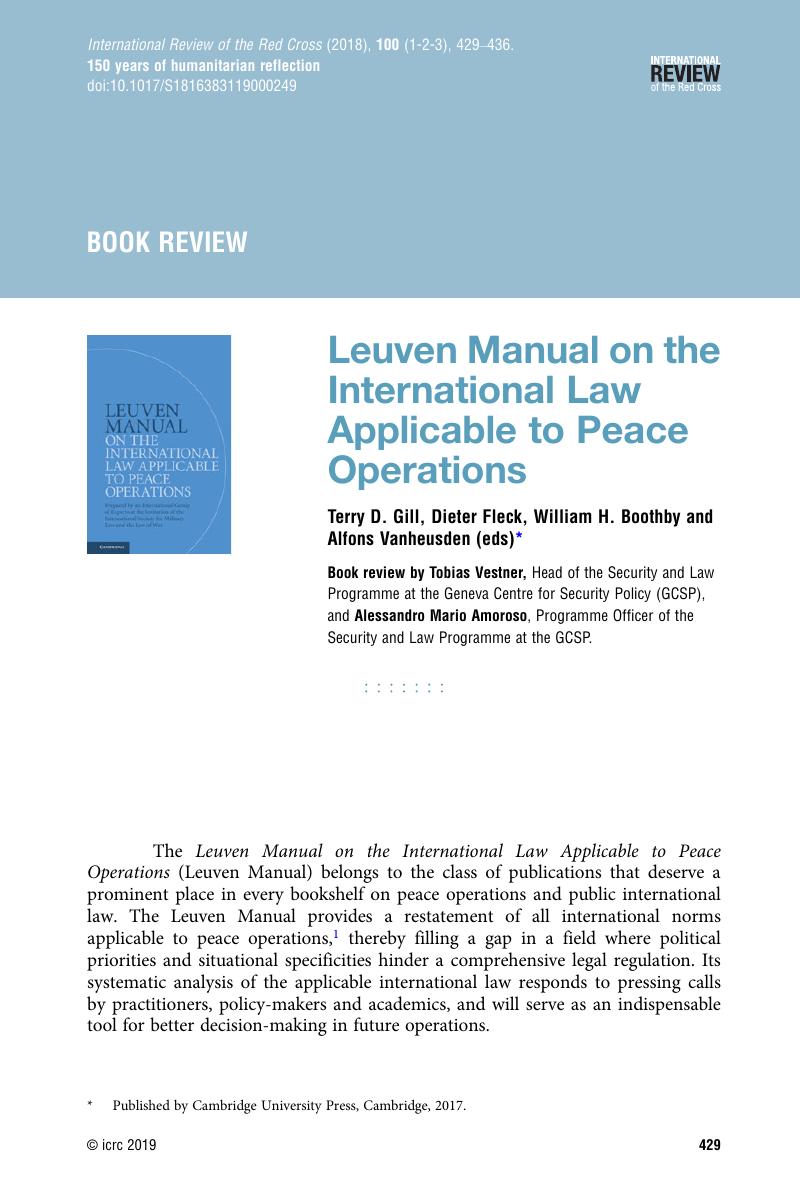Published online by Cambridge University Press: 20 May 2019

Published by Cambridge University Press, Cambridge, 2017.
1 The Leuven Manual, and this book review, refer to “peace operations” as including both peacekeeping missions and peacebuilding and conflict resolution operations. This choice reflects current United Nations (UN) terminology. On 1 January 2019, the UN Department of Peace Operations (DPO) replaced the Department of Peacekeeping Operations (DPKO). The new DPO combines the functions of the former DPKO with responsibility over field-based political missions previously under the purview of the Department of Political Affairs. See Restructuring of the United Nations Peace and Security Pillar : Report of the Secretary-General, UN Doc. A/72/525, 13 October 2017, para. 20 (approved by UNGA Res. 72/262 C, 5 July 2018), available at: www.un.org/en/ga/search/view_doc.asp?symbol=A/72/525 (all internet references were accessed in March 2019).
2 The composition of the Group of Experts and Observers and of the Advisory Board can be consulted at the beginning of the book: Leuven Manual, p. ix.
3 Chapter 2 of the Leuven Manual presents a short history of the law of peace operations: Leuven Manual, pp. 6–24. For an extensive account of political and legal theories on peace operations, see Bellamy, Alex J., Williams, Paul D. and Griffin, Stuart, Understanding Peacekeeping, 2nd ed., Polity Press, Cambridge, 2010, pp. 18–41Google Scholar.
4 Leuven Manual, p. 3.
5 The distinction between “peace operations”, “enforcement operations” and “peace enforcement operations” is today a conventional one. See Gill, Terry D., Fleck, Dieter, Cammaert, Patrick C. and Klappe, Ben F., “Peace Operations”, in Gill, Terry D. and Fleck, Dieter (eds), The Handbook of the International Law of Military Operations, 2nd ed., Oxford University Press, Oxford, 2015, p. 153Google Scholar; Findlay, Trevor, The Use of Force in UN Peace Operations, Oxford University Press, Oxford, 2002, pp. 3–7Google Scholar.
6 There have been only two uncontroversial examples of enforcement operations (in Korea from 1950 to 1953 and Operation Desert Storm against the Iraqi invasion of Kuwait in 1991) and a few more cases of peace enforcement operations. The latter include the mandate of the UN Operation in the Congo between 1961 and 1963, and, more recently, the Force Intervention Brigade of the UN Stabilization Mission in the Democratic Republic of the Congo since 2013. It is still disputed whether the robust mandate attributed to the UN Multidimensional Integrated Stabilization Mission in Mali qualifies as peace enforcement. Examples of non-UN peace enforcement operations are the International Security Assistance Force in Afghanistan and the Kosovo Force, both led by NATO. See T. Findlay, above note 5, pp. 374–381; T. D. Gill et al., above note 5, pp. 96–97.
7 Leuven Manual, pp. 76–90.
8 Ibid., pp. 91–104.
9 Ibid., pp. 267–287.
10 Ibid., pp. 311–327.
11 Ibid., pp. 52–75.
12 Ibid., pp. 105–119.
13 Ibid., p. 3.
14 Gray, Christine, “Host-State Consent and United Nations Peacekeeping in Yugoslavia”, Duke Journal of Comparative & International Law, Vol. 7, No. 1, 1996, p. 242Google Scholar.
15 See, among others, Orakhelashvili, Alexander, Collective Security, Oxford University Press, Oxford, 2011, p. 315CrossRefGoogle Scholar; Patryk I. Labuda, “Peacekeeping and Peace Enforcement”, Max Planck Encyclopedia of Public International Law, September 2015, para. 21.
16 T. D. Gill et al., above note 5, p. 154 (emphasis added).
17 As clarified above in the text, this would be the case for all non-UN operations covered by the Leuven Manual, whose scope of application is limited to consensual peace operations.
18 Leuven Manual, p. 29 (emphasis added).
19 Ibid., p. 27.
20 Eric P. J. Myjer and Nigel D. White, “Peace Operations Conducted by Regional Organizations and Arrangements”, in T. D. Gill and D. Fleck (eds), above note 5, p. 197.
21 Leuven Manual, p. 93.
22 Ibid., p. 147.
23 This is because these actions lack the necessary belligerent nexus. See Melzer, Nils, Interpretive Guidance on the Notion of Direct Participation in Hostilities under International Humanitarian Law, ICRC, Geneva, 2009, p. 61Google Scholar.
24 Unless he or she is directly participating in hostilities.
25 Provided that notably the requirement of belligerent nexus is fulfilled.
26 In order to determine whether an attack is unlawful for the purposes of direct participation in hostilities, what must be taken into consideration is the nature of the target, not the nature of the attacker or the means used. For an extensive argumentation, see Cameron, Lindsay and Chetail, Vincent, Privatising War, Cambridge University Press, Cambridge, 2013, pp. 464–476CrossRefGoogle Scholar.
27 It is noteworthy that this should not concern the active protection of civilians.
28 Leuven Manual, p. 98.
29 “Observance by United Nations Forces of International Humanitarian Law”, Secretary-General's Bulletin, UN Doc. ST/SGB/1999/13, 6 August 1999, Section 1.1, available at https://conduct.unmissions.org/secretary-general%E2%80%99s-bulletin-observance-united-nations-forces-international-humanitarian-law.
30 Ferraro, Tristan, “The Applicability and Application of International Humanitarian Law to Multinational Forces”, International Review of the Red Cross, Vol. 95, No. 891–892, 2013, p. 605CrossRefGoogle Scholar.
31 Leuven Manual, p. 606.
32 The Manual does not cover the protection of personal data. This topic has been discussed at the international conference convened in Dublin by the International Society for Military Law and the Law of War, from 14 to 17 November 2018.
33 Doswald-Beck, Louise (ed.), San Remo Manual on International Law Applicable to Armed Conflicts at Sea, Cambridge University Press, Cambridge, 1995CrossRefGoogle Scholar; Schmitt, Michael N., Garraway, Charles H. B. and Dinstein, Yoram, The Manual on the Law of Non-International Armed Conflict, International Institute of Humanitarian Law, Sanremo, 2006Google Scholar.
34 Program on Humanitarian Policy and Conflict Research at Harvard University, HPCR Manual on International Law Applicable to Air and Missile Warfare, 2009.
35 Schmitt, Michael N. (ed.), Tallinn Manual on the International Law Applicable to Cyber Warfare, Cambridge University Press, Cambridge, 2013CrossRefGoogle Scholar.
36 United Nations Peacekeeping Operations: Principles and Guidelines (Capstone Doctrine), 18 January 2008, available at www.un.org/ruleoflaw/files/Capstone_Doctrine_ENG.pdf.
37 Howard, Lise Morjé, UN Peacekeeping in Civil Wars, Cambridge University Press, Cambridge, 2008Google Scholar.